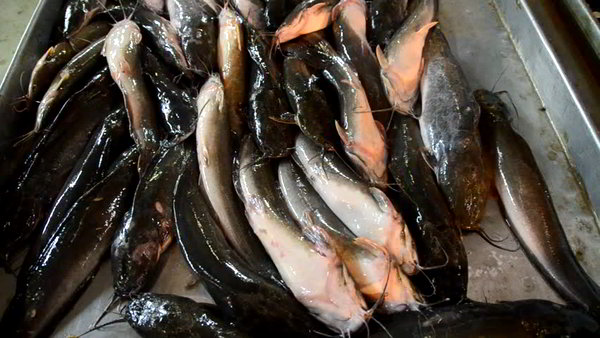Recently, Asian catfish has become a popular gastronomic addition to the Filipino diet because of its tender and delicious meat. This encouraged more farmers and entrepreneurs to venture into catfish farming. Our scientists recommend catfish farming because catfishes are resistant to diseases, can be stocked at high densities, and can tolerate low water quality.

While catfish farming is certainly not an easy venture, it has become easier to start and manage a catfish farm with the wealth of information produced by scientists from the Southeast Asian Fisheries Development Center- Aquaculture Department (SEAFDEC-AD). Below is the basic information that one needs to know in starting a catfish farm.
The Asian catfish
The Asian catfish (Clarias macrocephalus) is a freshwater fish that is indigenous to the Philippines especially in the Bicol region, Palawan, and some areas in Mindanao. It can be found in lakes, rivers, tributaries, and other freshwater bodies.
Sexes are separate in catfishes. Males have elongated urogenital papillae around the anus while females have a simple round opening. Asian catfish is distinguished from its lookalike- Thai catfish (Clarias batrachus) by the shape of the occipital process in the head. The occipital process is blunt or rounded in Asian catfish and pointed in the Thai catfish. Also, the Asian catfish also has small white spots along the sides of its body.
However, this species became scarce with the introduction of exotic fishes such as the Thai catfish (Clarias butrachus) in the 1980s.
Feeding and breeding catfishes
Catfishes are carnivores, but they also feed on small bottom-dwelling animals, rice bran, kitchen refuse, fishmeal, or formulated feeds. In a SEAFDEC study, scientists found that catfishes fed on a SEAFDEC-formulated diet with 43% protein had similar reproductive and larval quality as those fed with ‘trash fish.’
Catfishes mature after 6-8 months. Larger mature females produce more eggs than smaller females, each gravid female can lay 20-90 eggs/g body weight after hormone injection. Captive catfishes contain eggs and sperm the whole year but do not spawn by themselves. Artificial propagation involves inducing the gravid females to spawn by injection of different hormones, and manually stripping the eggs after several hours. Before females are stripped of eggs, male catfish are sacrificed. The male reproductive tract is then dissected and macerated to obtain the milt to fertilize the eggs. Success in induced spawning depends largely on knowledge of:
1. the optimum dose of hormones to be used, and
2. latency period, the time between injection of hormones and stripping of eggs.
Four to five days after hatching, catfish larvae are stocked at 30 per liter in bigger tanks. They are fed natural food organisms such as newly hatched brine shrimp Artemia for three days, and the waterflea Moina for another four days.
Thereafter, larvae can be weaned to formulate diets that contain 44% protein. Feeding should be done twice daily to two- to four-week old catfish fry at a feeding rate of 20% body weight and to older fry at 5-10% body weight.
The nursery tank or pond should also be fertilized ten days before stocking of catfish fry. Fifteen-day old fry may be stocked at 200-800/m2 in tanks and up to1200/m2 in ponds. More fingerlings can be obtained when the fry are grown in net cages suspended in either tanks or ponds. Fingerlings are harvested after 28 days, ready for stocking in grow-out ponds.
————
Source:
1. Nursery rearing of the Asian catfish, Clarias macrocephalus (Gunther), at different stocking densities in cages suspended in tanks and ponds, 2002 by Rudy Bombeo, Armando Fermin, and Josefa Tan-Fermin of the Southeast Asian Fisheries Development Center-Aquaculture Department (SEAFDEC-AD), Tigbauan, Ilo-ilo, Philippines
2. Seed Production of the native catfish (Clarias macrocephalus, Gunther) October 1999 by SEAFDEC
by Junelyn S de la Rosa, BAR Chronicle, June 2004 Issue (Vol. 5 No. 6)

I want to order. Please assist me.
more info video catfish motality rate tanks.